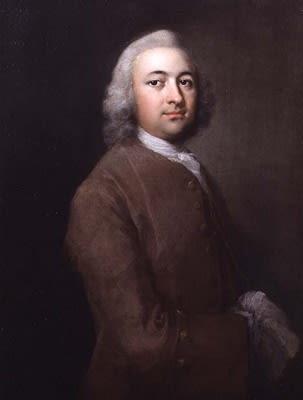
Thomas Frye
To view all current artworks for sale visit philipmould.com
Strickland notes that Thomas Frye was born in 1710 in or around Dublin, -1 and he was probably in fact the second son of John Frye (1670-1752) of Edenderry, Co. Offlay. Little is known about his early life or training, except that he was certainly in London by 1736, when he painted a formal portrait of Frederick, Prince of Wales for the Saddlers' Company. He quickly matured into one of the most versatile artist working in England at this period. As well as being an accomplished portrait painter in pastels, oils, and in miniature, he also produced probably the most original series of mezzotint studies of the 18th century in the British Isles.
As well as this he was one of the founders of the Bow porcelain factory, which he managed from 1744 until his retirement through ill-health in 1759. Indeed, in his obituary (Gentleman's Magazine, 1764) Frye is credited as the Inventor and first Manufacturer of Porcelain in England.2 However, during this period he did not abandon his work as a painter and draughtsman.
Amongst other evidence for this is a group of Frye portraits formerly at Plas Power near Wrexham, Wales that date from the 1740s. It is known that in 1759 Frye went on a tour of Wales to recover his health, during which he is supposed to have accepted portrait commissions. It is possible that Frye visited Wales fairly regularly and knew the area well.
A pair of portraits of Simon Lloyd and his wife by Thomas Frye (signed and dated 1749) from Plas Power was acquired from Lt-Col. G.E.Fitzhugh recently by Wrexham Museum. Another three-quarter length portrait by Frye of a Miss Myddleton was recorded in the 1960s at Plas Power. 3 It is dated by Michael Wynne toe. 1740.4
Our portrait, which also came from Plas Power, almost certainly depicts a member of the Lloyd family. Stylistically it displays all the qualities of Frye's most sensitive and accomplished portraits. The soft lighting, the feathery brushstrokes and the Rococo movement in the wig and elaborate cuff all show close affinities with the designs that were being produced in porcelain at Bow.
Plas Power, near Wrexham was a property originally owned by the Power family. At some time before 1720 the estate was acquired by Miss Mary Myddleton. In her will dated 20 April 1720 she bequeathed her lands to good friend and cousin, Thomas Lloyd and in the event of his dying in her lifetime to his eldest son William. The latter did inherit the estate and pulled down the old house, which in around 1757 he rebuilt.
In 1816 the house and estates passed to the family of Fitzhugh, by the marriage of a Lloyd heiress to Thomas Fitzhugh.